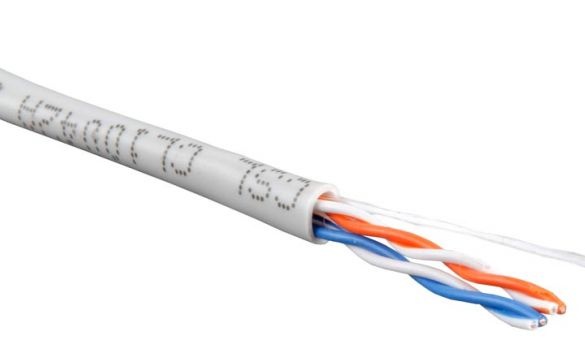An unknown primitive electrician of the middle of the XIX century, the first who rolled two wires together in rubber insulation so that it was more convenient to fix them on a porcelain insulator, did not even suspect what he had done.
The first to appreciate his accidental invention were not the energy brothers, but the signalmen - telegraphists and telephone operators.
The second century, their telephone communication cables, swirling in the dungeons of cities, are simply bundles of twisted copper pairs. Usually a person is not so observant to notice a twisted pair in wires suspended on classic wooden poles with cross-shaped traverses. Take a closer look, each pair of wires through several spans falls on a pole, on the traverse of which an iron cross with four insulators awaits it, where the wires are interchanged. Perhaps even very old lines have been preserved, where the crossing of wires takes a whole span between the supports, and for their separation in space one of the insulators was placed not on the traverse, but under it, on the hook. In any case, you have the same turns, only 200-300 meters long.
Twisted pair is perfect for transmitting information. The electromagnetic field of the signal, as you know, is concentrated in the plane between the conductors and within one full turn of this plane rotates 180 degrees. Each element of any turn corresponds to an element in an adjacent turn having the same spatial orientation, but with the opposite position of the conductors. High noise immunity of twisted pair cable is based on this topological property.
External interference in the line can be considered the sum of the interference induced in each of its elements. For a line of an even number of turns, the interference will be equal to zero, since each signal in any element of one turn has its “antipode” in the neighboring one.
If we analyze the radiation from a twisted pair at a certain point, then the signals from adjacent coils mutually cancel each other, since the radiation of each element of one coil has a pair of radiation of the same magnitude, with only a different sign, from an element in an adjacent coil rotated 180 degrees relative to it .
The quality of twisted pair performance is estimated by the step of the turn (the number of turns per unit length - meter, foot, yard) and the degree of stability of this parameter along the entire length of the line. It seems to be simple, but to withstand these requirements in artisanal conditions is very difficult. You can twist a not very long pair with a hand drill, but here's the problem, it tends to unwind on the one hand, and on the other hand, to twist in a ball. In any case, the quality of your work will be irreparably damaged. The point here is naughty isolation.
When working with long wires, it is noticeable that the natural sagging of the wires under their own weight begins to affect the density of the turns self-distributing along the line taking into account the voltage present in it. Where the stress from sagging is less, there they lie thicker.
Tip one.
Do not work with horizontal, but with vertically hanging wires. In the city, roofs, balconies and stairwells in the porches are suitable for this. The wires are fixed at the bottom, and with what you will twist - at the top. The turns are smooth along the entire length of the wires.
Tip two.
Removing residual stresses in the insulation of individual cores after twisting them, the process is long. I recommend leaving the line at the place of manufacture for up to an hour in a tense state, under load. In the vertical version, it is simply a load suspended from the lower end and secured to prevent rotation.
If the cores have rigid insulation that cannot be tamed with a load, there is a very effective technique. At one end of the core, it is necessary to electrically connect each other and pass through the formed circuit a current sufficient for moderate heating of the wires (up to 40-60 degrees). The temperature can be determined by hand - hot, but you can hold.
Any adjustable laboratory power supply is suitable. The best thing is if it has a current limit setting function. If there is no such function, a current-limiting resistor must be connected in series with the line.
In such a heated state, the insulation of the line becomes plastic and under stress, all internal stresses are removed. By the way, with this technology, twisted pair is obtained of very high quality, indistinguishable from industrial counterparts.
Evg. Svishchev

